LILA: Thank you Bryan for agreeing to interact with us. You have been creating self-portraits every single day since 1995, in an attempt to record/represent your daily change/growth as an artist. You mentioned that given the regularity of this practice you could even draw yourself blindfolded, or in sleep. Does regular practice make art mechanical at any point?
BLS: It can. Whenever you repeat a behavior or sensory experience, you form and prune a neurological pattern and this process tends toward accuracy and efficiency the more it is repeated. It is the body’s way of conserving energy. Some artists embrace this and some artists fight against it.
Insanity is often defined as repeating the same behavior over and over again and expecting different results, but the thing with daily-self-portraiture, and drawing in particular, is that it makes evident the fact that no two moments in time are ever the exact same because the results are always different. The act of drawing is mechanical, but also mental, emotional, experiential, temporal and so on, it has the ability to contain and convey a lot more information than the other forms of art. This allows for variation within the same repetitive act to open up and become infinite.

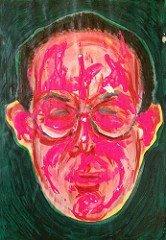
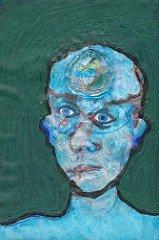
The artist spent 30 days each, from October 1998 to January 1999, surrounding himself for 24 hours a day with yellow, red and blue flood lights respectively.
LILA: Where do you think creativity comes from? How do you manage to re-create yourself every single day?
BLS: Sometimes I look for something novel or different to focus my attention on and sometimes I look for patterns and associations. Sometimes I record an event. Sometimes that event is imaginary… The possibilities are endless.
Creativity comes from the merging of two different kinds of mental processes. The first process involves the relationship between novelty and pattern. Our attention always directs us to differences. It is hard to avoid noticing things that change or are different. Every change that we experience in our mind, body or environment, like when a new feeling, sound or object stands out, directs us towards it because it is different. We are hard wired to perceive change and novelty. At the same time, learning comes from pattern and repetition. We generate the meanings and causes of everything through them. As we go about our day our senses are continuously running everything we experience against the patterns we have already formed in our brains. This happens consciously as well as unconsciously and when something is out of place and doesn’t fit a pattern it stands out and ignites our attention. Difference allows for changes in the pattern. That is one process. The second process underlying creativity involves alternating states of mental activation. When we are engaged in problem solving the mind becomes ‘extra active’ or focused on that problem. When relaxing, sleeping or daydreaming, mental activity is ‘under active’ or not focused on the problem at all. Creative thoughts arise during states of mental under activity after first being in a state of over activity. This is why it feels as if the creative spark arrives out of thin air because creativity happens when the mind is not currently focused on the problem. For creativity to happen there must be periods of purposeful, repetitive focused thought, pattern activation followed by periods of mental rest so that novelty and differences have a chance to emerge and connect with it and in some cases create a new pattern. Does that make sense? It is actually a bit more complicated than that with the overlapping of different patterns and the associations between multiple patterns and the involvement of expectation and states of surprise, but the first two processes are about as far as I’m able to keep track of and describe.
LILA: Does the task of assessing yourself everyday take a toll on your mind? If yes, in what way, and how do you contain it?
BLS: No. Not at all. It is a helpful, healthy liberating experience. I would say it is the complete opposite of a toll. It is often therapeutic and engaging in positive healthy ways and provokes thoughtfulness and empathy and more.
By drawing myself everyday, I’ve learned that my emotions emerge from and are defined by the physical sensations that I experience in a particular context. When I feel a change, say a racing heartbeat or shortness of breath or sweaty hands, I often use that as the starting point for my drawing. As I’m drawing, focusing, interacting and expanding on my physical presence, I can see myself labelling these experiences as panic, or frightened, or afraid. Once I have this awareness I can change my behaviour (by breathing deep and slowly for example), thus gaining influence over both the judgment of what I’m feeling as well as what I am actually feeling. A real back and forth communication can take place. This kind of practice of emotional control evokes empathy by expanding my understanding of what is taking place inside of me. It also allows me to remove or at least redirect a lot of my negative feelings by actively engaging in the process of making meaning. At the onset I can say “I feel this way because of social anxiety”, but then by recognising that I can purposefully smile and include my physical sensations of smiling into the picture, that gives me room to transform the emotion of anxiety into a wondrous excitement. Knowledge of these kinds of processes expands my awareness of what might be going on in others as well.
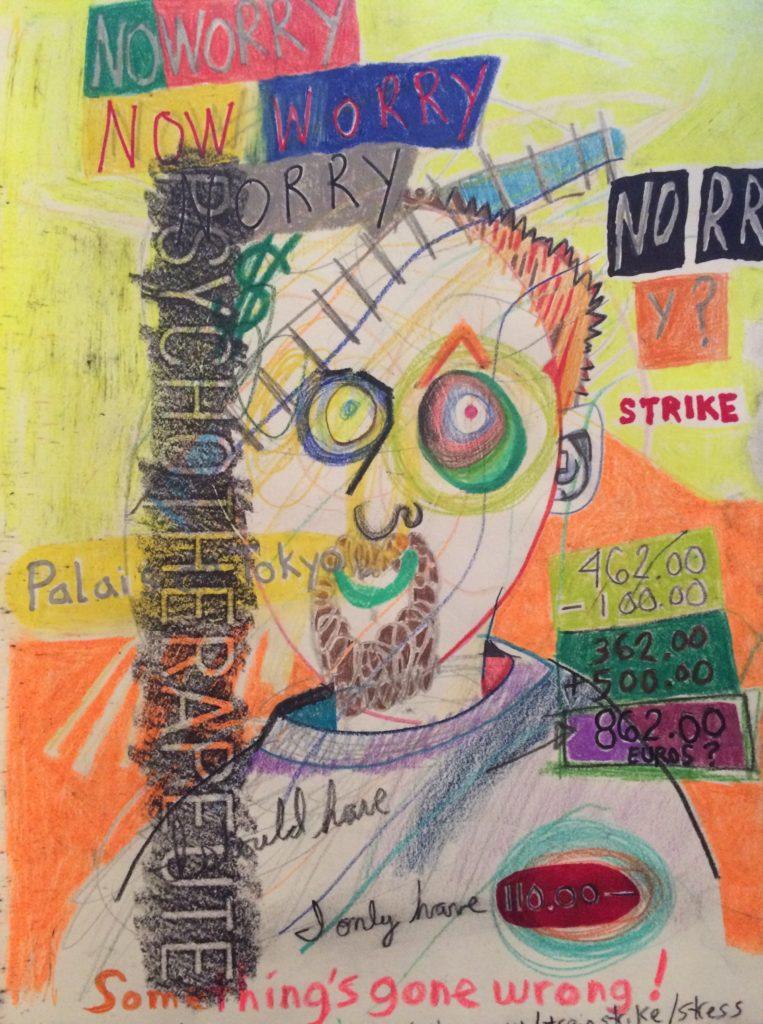
“…but then by recognising that I can purposefully smile and include my physical sensations of smiling into the picture, that gives me room to transform the emotion of anxiety into a wondrous excitement.”
LILA: You have done various experiments to fuel your art – most involving putting yourself through repeated self-abuse. What are your motivations to do this? Why do you put yourself through torture again and again?
BLS: Only the most sensational or ‘popular’ experiments have these self-destructive elements. Those are the ones that get the most media attention. The vow of silence, totally blind month, “sensations” experiments, sexual arousal and color environments… none of those had a self-destructive aspect to them at all. When I was younger I had a lot of guilt and after prison I switched from harming others to harming myself. As I got older I began looking for ways to make art an act of health and concerned myself more with homeostasis, balance and improvement. For me, the art that I consider self-abusive or self-destructive is illustration and graphic design. Those types of art, like making album covers, are extremely painful and torturous to me both physically and mentally. They cripple my body and bring about suicidal ideation. I’m not exaggerating.
LILA: You did a series of drawings ‘While Being Tortured’, which, as the name of the series suggests, involved harrowing experiences of physical torture, while your other works, like those on drugs, or the ones created as you hampered your somatic senses, involved other kinds of distress. Could you describe your experience of these experiments a little bit? How did they impact your mind? Do you think they added to you as an artist?
BLS: I don’t know if they added much to me as an artist but they have in some ways benefited my life. See, I always try to face my fears as I become aware of them and sometimes I use art like exposure therapy. So, for example, if I become aware that I fear something, like being tortured, I will make art about it. I will research torture and do some daily-self-portraits of myself being tortured whenever the fear arises, and if it gets to a point where I feel it is needed, I will then advance towards actually experiencing it, face it and draw myself and my feelings in the moment while I am being tortured and eliminate that fear. I’m concerned with the entire spectrum of experience of which distress is only a part. Very early on, after only a couple of years of doing daily-self-portraiture, I began to realise the importance or influence that the environment has in self-perception. I now know that we are physically connected, literally physiologically connected to our environments by our senses, and it is near impossible to fully detach from what is around us. But back then I thought of it differently and mental state permitting, I would try controlling and sometimes drastically designing my environments in an effort to experience as much of life as possible. During this time I came up with a way to chart or graph emotions mathematically in three dimensions. I call the three axis, along with Focus and Motivation the ‘basic elements of experience.’ [Focus, Valence, Arousal, Stress, and Motivation.]
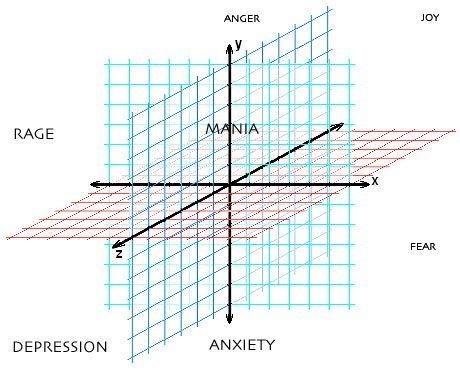
The Affective Experience graph. Here is a 3-D interactive rendition: https://mvollrath.net/BLS/. Credits: Saunders & Volrath 2017
By being able to evaluate and graph a daily-self-portrait by calculating the elements within them I’m able to see my range of experiences more accurately. Using these images like data I’m also able to see the shape of my personality. Seeing the self from this type of external perspective allowed me to think of drawing and daily-self-portraiture in a totally different way. Each of the elements of experience are made up of different components and by purposely manipulating those components when drawing I am able to engage with my experiences and interact with my observations more purposefully as opposed to just drifting through life recording whatever happens to me. Instead of manipulating the art materials to create an object, I manipulate myself (mind, body, environment) because I am the lens with which I perceive, come to know and create everything through. I sometimes manipulate the elements of experience in order to create a more informative or accurate version of my self at any one moment and sometimes I do it to materialise my will for the future. Daily-self-portraiture is not about the creation of an object every day. It is about the act. To increase emotional affect. To expand experience… Painful and pleasurable events are components of our Valence just as Attraction and Aversion and many other things. Every experience adds to one’s perception and the more different and intense the experience the more influential it is.
LILA: Talking of pain, it is often said that art is best fueled by pain and suffering. Do you agree with this premise? Do you think artists need to go through such experiences to be creative and meaningful?
BLS: It depends on the kind of art. Most people are attracted to art that possesses an intensity of some sort. Sometimes it’s an intensity of concentration (i.e. details), other times it’s an intensity of feeling or emotion that they are drawn to. Sometimes people are drawn to an intensity or complexity of an idea and sometimes there is an intensity of visual sensation (i.e. intense colors and shapes). Sometimes it’s even the celebrity or intensity of popularity that they are drawn to. Pain and suffering often inform a lot of physical and mental intensity but there are lots of different kinds of art so it is definitely not needed in my opinion.
LILA: What in your opinion is the purpose of art in our times?
BLS: Art has always been a tool. Today there are many different kinds of art and many different kinds of uses for it. Some people use it for communication and marketing and branding while others use it for psychological therapy. Some use it as an investment and some use it as a symbol of affluence. Some also use it as a distraction. I try to use it in a lot of different ways too but to me, true art is about advancement and development, growth beyond homeostasis and the improvement and strengthening of oneself above and beyond health. Being influential is great but inspiring others is even greater. To move forward. To put forth ideas and knowledge that generate more thought while at the same time leaving room to mutate into future generations. To make art a biological advantage for those whose nature and/or nurturing haven’t been sufficient enough for survival. These are some of the things that I think art should be more of.
LILA: You described an incident where an obese woman was willing to pay people to break her jaw, so it could be wired shut, and many people came to ‘help her’ in this task. Why do you think the human mind gives in to violence and suffering? How do you think about this affinity?
BLS: Maybe because we have been animals much much longer than we have been humans? I never think about these things. That is a great question!
LILA: While most of your popular work revolves around radical experiments, you have also created various artworks in mundane settings – like the one while you were working at McDonalds. Does art change for you, when it comes from different mind-spaces and different experiences?
BLS: Yes, that is the purpose of the experiments. To manipulate experience and observe the results. To form ideas and test them against experiences. To create a dialogue with my perceptions and communicate with my observations.
I don’t look at it as if the art changes under different experiences. I look at it more like the basic elements of experience themselves change, and I see this happening when I’m making art. My motor skills may be reduced by alcohol but they can also be impaired after I engage in a behavior that expects me to use different patterns of movement too. For example, putting mustard, ketchup, mayo, cheese, onions and pickles on 300-400 sandwiches in an hour will impair my motor skills as well, and it is the act of drawing that allows me to perceive these changes and not the comparison between the two finished objects.
LILA: You have mentioned earlier that your experience at the Lorton Correctional facility changed your life forever, for the better. How? Could you elaborate?
BLS: On the one hand I got my GED (high school equivalency) and with that I was able to attend college because of prison. On the other hand I experienced things that changed my entire self-perception. I mean I thought I was a pretty violent person until I saw institutionalised brutality. And people being sexually assaulted and murdered. I thought I was desperate until I saw people hoarding their waste and using it as a weapon. I thought I was a psychopath until I was surrounded by hundreds of them. The experience also took away my desire to be independent and self-sufficient. Being in prison forced me to rely on the state for food and shelter making it normal for me to take handouts from then on. And in return this has allowed me to focus on art more than my basic needs for survival.
LILA: You not only paint and draw, but also do music, poetry and dramatic live performances, Stand-up Tragedy being a signature style. Could you tell us about these different practices? When did you diversify, and why?
BLS: First, I did 10 years of daily self-portraiture only. That was chiefly a form of intrinsic emotional control. Then when I began recording and performing that turned my conscious concerns from intrinsic to extrinsic emotional control or trying to control the emotions of others. I did that for about 10 years and now I am in a period of assessment with the desire to focus full time on drawing and life experiments.
LILA: How are the diverse styles of your art seen and received by audiences?
BLS: I can only guess that some people prefer my poems and stories, while others like my drawings. Maybe some prefer my performances… I don’t think many people appreciate everything equally.
LILA: Your life has taken you from being considered a precocious child, to being put in a group home when you were still quite young. Could you tell us a little more about this trajectory? How do you reconcile these experiences with your adult life and understand your mind now?
BLS: I was an adult when I first went into a group home. Almost 33 years old. I was placed on a farm with people who had Down syndrome and other severe mental disabilities. By that time I was getting really good at reading my feelings through the daily-self-portraits and using them more and more frequently to predict my future. Over time I began to see patterns develop, where certain media and forms and colors would appear prior to certain behaviors and that would signal to me what types of events may lay ahead.
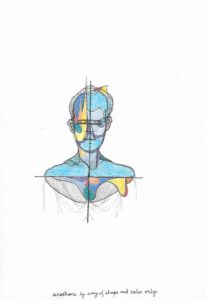
“Sensations by way of shape and color only”
Unfortunately with this inner knowledge I began to fulfill prophecies of doom. (For example, on October 29th, 2001 I drew myself with a utility knife threatening a specific person and then when that person broke into my house on November 8th I cut him with that very same knife and then I drew myself with water and police fingerprint dust later that evening. Then on the next day, October 9th, I drew myself cutting his nose off). I went into the mental hospital and group home system voluntarily to prevent the futures that I was perceiving.
Today I use the daily-self-portraits in a more proactive preventive way. Instead of using them to try and predict my future I use them to alter my current state of being which limits the possibilities of negative events before they take place. This probably sounds crazy but it is very real.
LILA: What are some of the experiences that have been key to your work? Can you look back on these experiences and say when something influenced you, how and why?
BLS: All of the drawing and life experiments have been really influential. Causation is extremely difficult to determine though with any level of certainty. I can create my own meanings and causes and say this influenced that but in reality that is probably not really the case at all. A good example is how for years I would tell people that I began doing daily-self-portraits because of reason A but then after reading all of my art journals I discovered that there was likely a combination of 10 or more different reasons that each led to that act. I think reading all of my journals has had a profound impact. Most influences are subconscious.
LILA: Do you have any connection with your contemporaries in the art, music and performance world? Are there any influences you take from history?
BLS: I could probably list 50 people. Some living, but most dead. Art has the power to keep some people alive. Even though they might be physically dead we can still connect with them and be inspired by them and communicate with them as if they are still with us. I always recommend people look into John Duncan. His importance to the arts is deeply profound.
LILA: What are your thoughts on happiness? Between all the torture and suffering, how do you understand joy, pleasure and contentment?
BLS: I use happiness and joy to prevent panic and social anxiety and sometimes even deter anger. Peacefulness is very important too. Peacefulness and joy are the two most contagious categories of positive feelings. I have a slideshow video of 895 happy daily-self-portraits. It has every single one of my most happy moments from the last 22+ years on it. I can watch it and become incredibly happy but only if another feeling is not already dominating the moment. For example, it is difficult to become happy once angry, but it is easy to not become angry if I’m already happy. Emotions are contagious especially our own and drawing is the best vehicle for transference. Expression is better than repression and prevention is better than treatment.
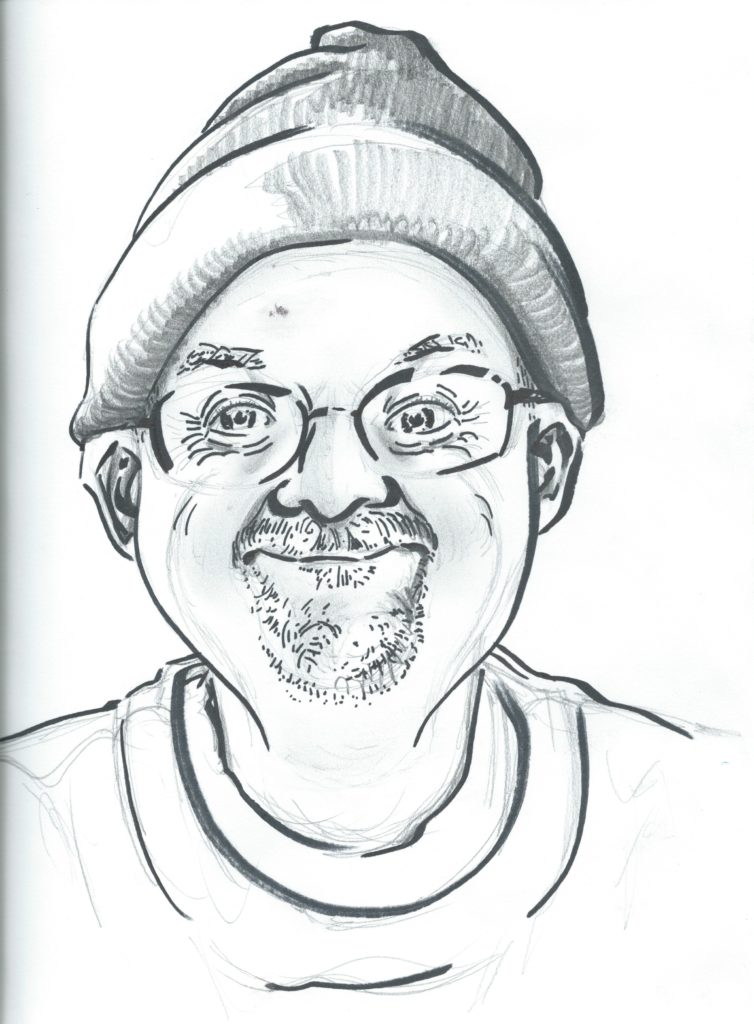
Bryan Lewis Saunders’ new book, a compilation of all the interviews he has done in the last ten years, is available here: ‘The Interviews Vol. 1’ http://bryanlewissaunders.org/weblog/2018/sep/17/interviews-book/
Art of Darkness, a feature film documentary on Bryan’s incredible journey is available here: http://bryanlewissaunders.org/weblog/2018/mar/20/aod-blu-ray/
